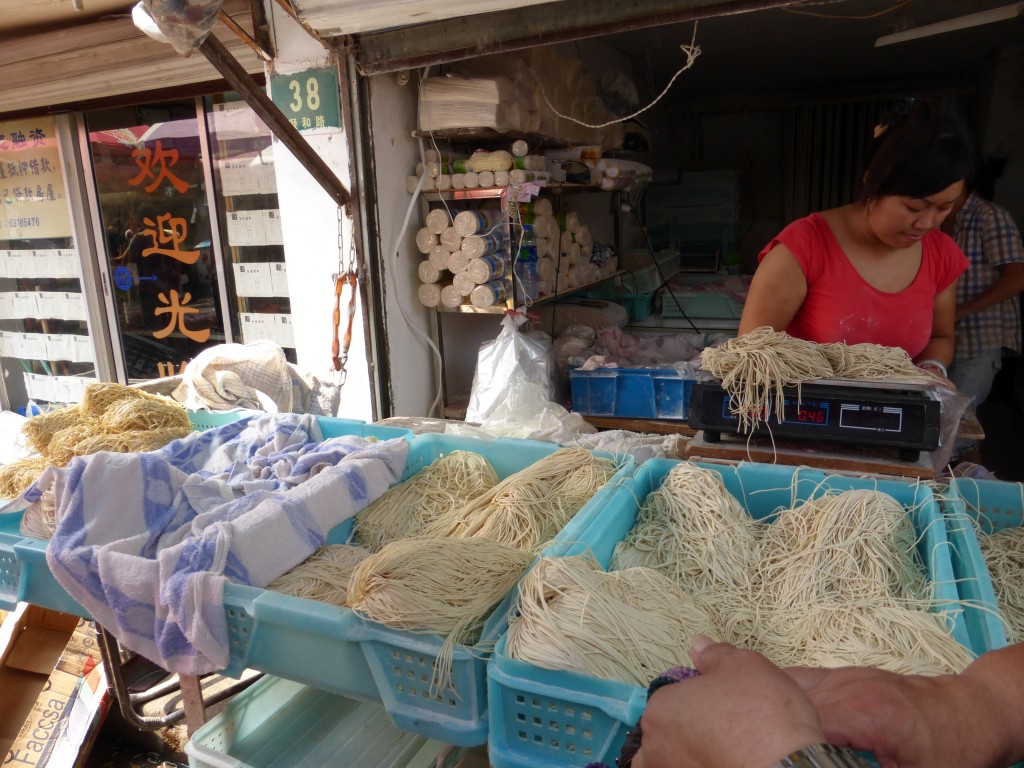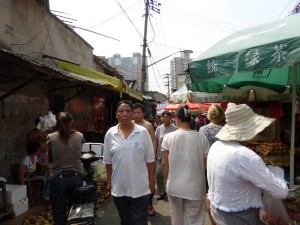
Before coming to China, I knew there would be some different items on the menu. I knew that the Chinese food I had in the States was a bastardized version of the real stuff. As I wasn’t a huge fan of that version anyways, I wasn’t expecting to find myself in a cultural cuisine heaven here in China. Further admitting to my lack of the palate needed for Asian cuisine, I foolishly also believed that a fortune cookie was authentically Chinese until I recently attended a dinner at a restaurant here specializing in American-bastardized Chinese food, appropriately named “Fortune Cookie.”
What I wasn’t prepared for was the exoticism that would be a typical trip to the market here. I have come to love open-air markets since we made our first international move a year ago. The brightness of fresh produce, the mouthwatering aromas from the grills, and the lively calls from the vendors urging you to stop and look at their selections, it’s always an incredible experience. From the feiras of Brazil to the orderly market day in a European town to the nostalgia of an American farmer’s market, these open-air grocers are a healthy and vibrant shopping experience.
What you’ll see, smell, hear and (possibly) taste in a Chinese wet market
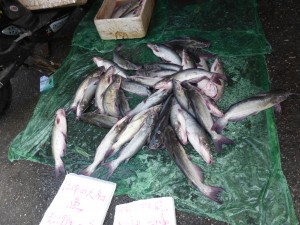
A wet market is the open-air market where you can buy produce, meats, spices, eggs and other groceries. It is so called a wet market because the vendors are consistently washing down the vegetables or pouring fish out of containers and the water flows down the street. There are air-conditioned super markets here, such as the French CarreFour, and I have even found Kate & Kimi, an online community supplying deliverable groceries. The wet market, though, is the authentic Chinese grocery shopping experience.
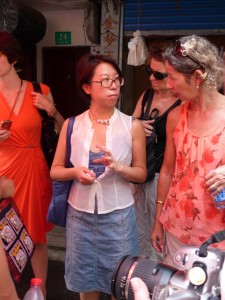
Upon arriving here in Shanghai, I immediately sought out expatriate organizations that had proven to be lifesavers in our other destinations. With some research, I joined the Shanghai Expatriate Association. Like the São
Paulo International Newcomers Club, the organization offers social and cultural outings to teach foreigners about the Chinese and Shanghai culture. I recently booked a tour of a Chinese wet market through SEA. Our tour was led by Janny Chyn of Shanghai Pathways, a tour agency that specializes in tours of unique and hidden areas of Shanghai. Janny provided a very informational tour of Penglai Lu Market, one of the first and currently the largest wet market in the city.
Breads and noodles
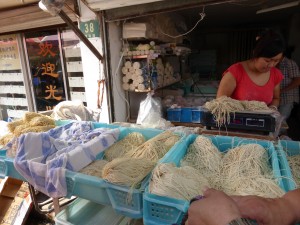
We started by venturing out onto the first long street of vendors. The first thing you notice is the crowd. The street is narrow, and there are hundreds of people dodging motor bikes and men with carts ringing a bell to signify they are collecting plastic containers as the recycling system isn’t that advanced here.
At the top of the street, a vendor was making Chinese pancakes on a griddle. This flat bread is spread with honey and rolled up for easy take-away. Our next stop was at a vendor selling heaps of different noodles. According to Janny, the Chinese, not the Italians, actually are to be credited with the founding of pasta. Marco Polo took noodles home to Italy after one of his expeditions to China, and the Italians created pasta based upon these noodles. It seems, though, that there is quite a bit of debate on this topic.
Dairy and eggs
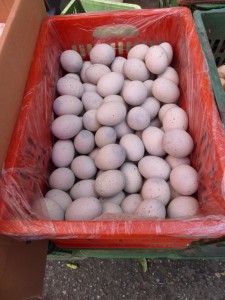
As we moved further down the hustling street, we stopped at a great display of eggs. There were white ones, brown ones, speckled ones and oddly blue ones. Known as Century Eggs, these blue ones are placed in the ground to ferment for months instead of years. The whites and yolks become a black jelly inside and are eaten as one would eat a hard-boiled egg. If you can get past the look, texture and smell, I’m told that are quite good. As a rather picky eater, I wasn’t able to get past the first three senses.
Though it is largely believed milk is not popular in China, Janny said this is not the case. Chinese rather enjoy their milk if not the cheese. Tofu is actually a replacement for most things cheese here. Janny told the story of how milk came to the country in the 1800s. An American businessman noticed there was a lack of good milk in China. Not part of the traditional diet, there wasn’t a need for such a source. He set out on a Public Relations campaign to introduce and develop a strong market for milk in the country, and it has been booming ever since. Most of the milk is imported, but there has been some recent scares in production.
Vegetables, beans, spices and nuts
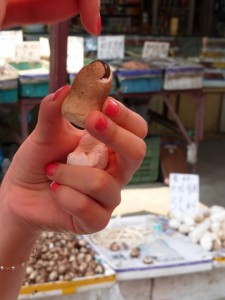
We moved on to the first stall of nuts, beans and spices. Janny proceeded to explain that in Chinese culture, it is believed that the food matches the body parts it resembles. For example, red beans are believed to be beneficial for the blood, walnuts are good for for the brain, and kidney beans support the kidneys. I found it very interesting that the Chinese believe purple food, like eggplant, is a good preventative for cancer. Maybe it is no surprise, then, that the American Cancer Society uses a purple ribbon to raise awareness about cancer.
Next door was a vegetable stand with a variety of produce. Especially interesting were the mushrooms, which came from all over the country. One in particular is called the hidden mushroom. It’s as if you can get a two-for-one. Inside the first mushroom a second mushroom grows.
As most homes don’t have the space and food is not doused in preservatives here, most Chinese go to the wet market daily as they only buy a one-day supply at a time. Some haggling does take place at the wet markets, but the price is plainly posted on many items. At the low costs (I bought two bunches of asparagus for the equivalent of less than $1), it seems a bit stingy to even attempt to get a lower price.
Meat
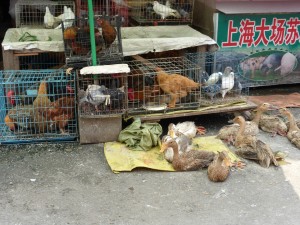
As we made the turn onto the next street, I saw them and my heart sank. Inside cramped cages were ducks, chickens and pigeons. Beside them were about 20 frogs in a large bowl. Every now and then, a frog would try to jump out only to be thwarted by the mesh covering over the bowl. A tank of slithering eels came next with the bodies squirming up through the mesh. Known as a delicacy in Shanghai, the eels were pushed back down into the tank by the vendor or snatched out to be skinned. A specialty for the city, hairy crabs pinched out of from their steel cages hoping to catch a vendor’s finger as he snatched them out to beat them with a hammer. All sorts of fish floundered in tubs of shallow water.
The exoticism of seeing your meat alive and jumping was a bit much to take. If I eat meat, it’s mainly chicken, and I have no desire to see what it looked like before it was slaughtered or for it to resemble itself in anyway once it’s on my plate. Here in China, however, that is opposite of what is normal. The Chinese believe that it is best to buy meat alive and butchered in full view. This way, you can see if the animal is healthy and ensure you are receiving the freshest cut. It’s also very typical to serve meat in its original form. Plenty of restaurants here serve the chicken with its head and feet (it’s a popular belief that chicken feet are good for a woman’s complexion) still attached or a fish with its eyes still staring at you. Bones are also left in many animals as the Chinese believe the best meat is located nearest the bone.
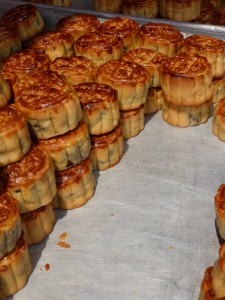
Holiday foods
There are many festivals on the Chinese calendar, and each comes with a special food. There is sticky sweet rice for the Dragon Festival, and, most recently, moon cakes for the Moon Festival. These special treats are a big hit in the wet market.
With eight distinct food regions in China, the country has a well-versed menu for any palate. To make these unique dishes, wet markets are the traditional means to buy the freshest ingredients. Though a bit of an attack on the Western senses, I would certainly recommend a stroll through these open-air smorgasbords of sights, sounds and smells.
What has been your strangest grocery shopping experience?
-Monica

